Adaptive archery equipment for quadriplegics includes sip-and-puff systems, mouth tabs, and electronic release aids that facilitate independent shooting despite limited mobility. You’ll find wheelchair-mountable bow stands, specialized aiming devices with laser guidance, and custom quivers for easy arrow access. Training approaches focus on core strength and proper technique, while classification systems guarantee fair competition opportunities. These innovations have transformed archery into an accessible sport where specialized technology opens a world of competitive possibilities.
Understanding Quadriplegia and the Archery Challenge
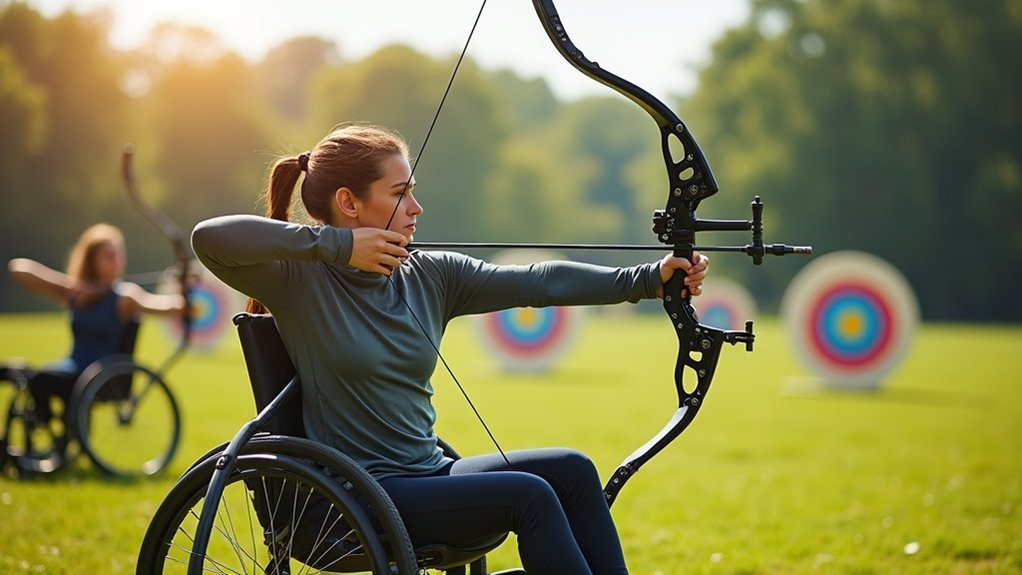
While archery requires precision and control that many take for granted, quadriplegic athletes face unique challenges due to impairments affecting both their upper and lower limbs.
These limitations often impact their ability to draw and release the bowstring effectively, requiring creative solutions and specialized equipment.
Adaptive equipment transforms limitations into new pathways for quadriplegic archers to excel with precision and control.
You’ll find that many quadriplegic archers develop remarkable adaptive techniques, such as using their mouth to draw the bowstring when arm control is limited. Organizations create comprehensive classification systems to accommodate these unique needs in competitive settings.
This determination showcases the incredible adaptability of the human spirit.
The sport is made accessible through carefully designed categories that group athletes with similar impairments together, ensuring fair competition.
Despite these challenges, quadriplegic athletes continue to excel in archery competitions worldwide, demonstrating that with the right equipment and adaptations, the sport remains accessible to all.
Sip-And-Puff Systems: Breathing New Life Into Archery
You’ll need to master precise air pressure control to effectively operate sip-and-puff archery systems, which respond differently to gentle sips versus forceful puffs.
Installing these systems requires mounting the pneumatic switches securely to your wheelchair and routing the air tubes to prevent kinks or obstructions.
After installation, you’ll spend time calibrating the sensitivity settings to match your breathing strength and comfort level, ensuring reliable trigger activation during competitive shooting. Most systems include integrated test buttons that allow you to verify functionality without activating the archery equipment.
Air Pressure Control Mastery
Breathing transforms into precise action with sip-and-puff technology, revolutionizing archery accessibility for quadriplegic athletes. You’ll gain remarkable control through subtle air pressure changes that trigger bow mechanisms with precision.
| Control Type | Benefit | Application |
|---|---|---|
| Gentle Sip | Arrow Release | Competition Shooting |
| Strong Sip | Safety Lock | Emergency Stop |
| Gentle Puff | Aim Adjustment | Fine-Tuning Targeting |
| Strong Puff | Equipment Reset | Between-Shot Setup |
Mastering this system requires practice but conserves muscle energy while enhancing focus on form. The intuitive design allows for customized sensitivity settings matching your specific needs. You’ll appreciate the consistent release mechanism that improves accuracy and reduces arrow contact issues. With proper training and regular maintenance, you’ll experience archery with newfound independence and competitive equality.
Installation and Calibration Steps
Setting up your sip-and-puff archery system requires proper installation and careful calibration to transform breath control into accurate shooting.
First, verify compatibility between your system and bow equipment before mounting it securely to your wheelchair. Position the mouthpiece for comfortable, consistent access.
Calibrate sensitivity settings to match your breathing strength, adjusting the threshold between sipping (inhaling) and puffing (exhaling) commands.
You’ll need practice sessions to fine-tune these settings while implementing safety features to prevent accidental releases.
Consider integrating your system with other adaptive equipment like bow supports or electronic releases for enhanced performance.
Regular technical support and feedback will help refine your setup over time.
Remember to check competition regulations if you’re planning to participate in formal archery events.
Mouth Tab Mechanisms for Independent Shooting
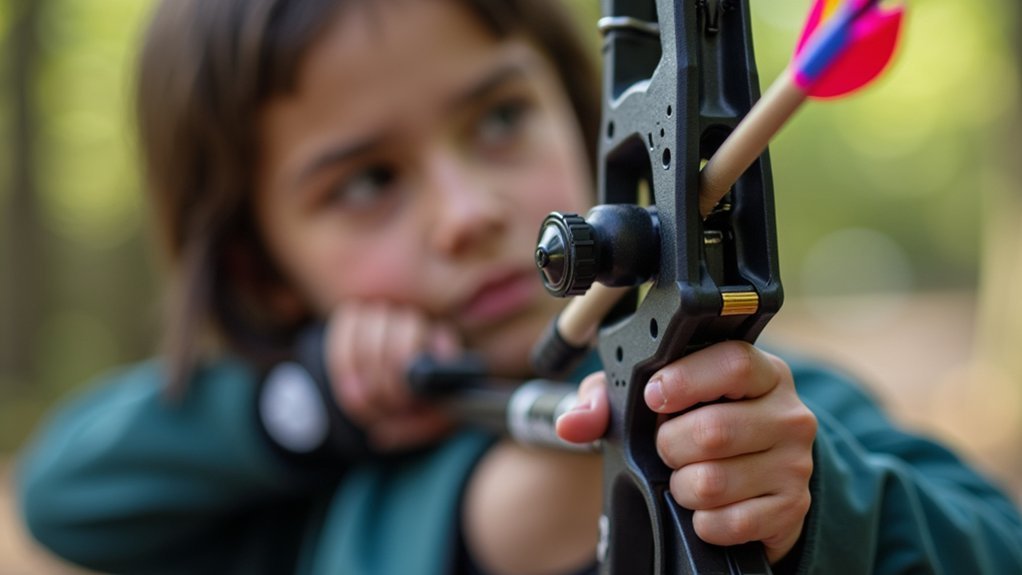
Mouth tabs feature specialized designs with leather or synthetic materials that withstand repeated biting while maintaining string attachment integrity.
You’ll progress through a structured training regimen, starting with dry firing exercises before moving on to actual arrow releases.
Your practice routine should focus on developing consistent bite pressure and clean releases to achieve accuracy comparable to traditional finger or mechanical methods.
Tab Design Fundamentals
Three vital elements define effective mouth tab design for quadriplegic archers seeking independent shooting capabilities.
First, durability matters—heavy nylon straps withstand repeated use while providing the necessary stability for consistent draws.
Second, proper placement is fundamental; you’ll need to position the tab below the nocking point and adjust it to accommodate your specific draw length.
Finally, consider the tab’s integration with your release mechanism. Whether you’re using a chin-triggered system or a mouth-activated release, your tab should complement this setup.
The ideal design provides comfort during extended practice sessions while maintaining sensitivity for precise control. You’ll need time to develop the muscle memory required for consistent performance.
Remember that well-designed tabs not only enhance accuracy but also guarantee safety during your shooting sessions—a vital consideration for all adaptive archers.
Oral Training Progression
Developing proficiency with mouth tab mechanisms requires a structured training approach tailored specifically for quadriplegic archers. You’ll begin with basic setup techniques to secure your bow in a position that enables mouth-controlled activation.
| Training Phase | Focus Area | Success Indicator |
|---|---|---|
| Foundation | Basic setup & positioning | Consistent bow stability |
| Development | Drawing with mouth/chin devices | Controlled tension maintenance |
| Intermediate | Aiming with adaptive sights | Grouping arrows on target |
| Advanced | Independent shot completion | Minimal external assistance |
| Mastery | Competition preparation | Consistent scoring improvement |
As you progress, you’ll gradually increase practice intensity while working toward independent shooting. This incremental approach builds confidence while enhancing coordination. With patient instruction and customized equipment adaptations, you’ll develop the skills needed for independent archery despite limited mobility.
Electronic Release Aids and Control Systems
For quadriplegic archers with limited upper body mobility, electronic release aids and control systems represent groundbreaking innovations that make archery accessible and enjoyable.
Sip-and-puff systems allow you to control releases through breathing motions, while mouth tabs enable drawing and releasing using only your oral muscles.
Electronic releases automate the process with precision, integrating seamlessly with smart release systems for a fluid shooting experience.
Electronic precision and smart integration create a seamless archery experience when traditional release methods aren’t viable.
You’ll find body-supported bow stands particularly helpful as they bear the weight of your equipment.
Audio feedback systems provide alignment cues, while laser sights project precise aiming points onto targets.
For maximum independence, look for equipment with modular designs and interchangeable parts that can be customized to your specific needs and attached to mobility devices like wheelchairs.
Wheelchair Mounting Solutions for Bow Stability
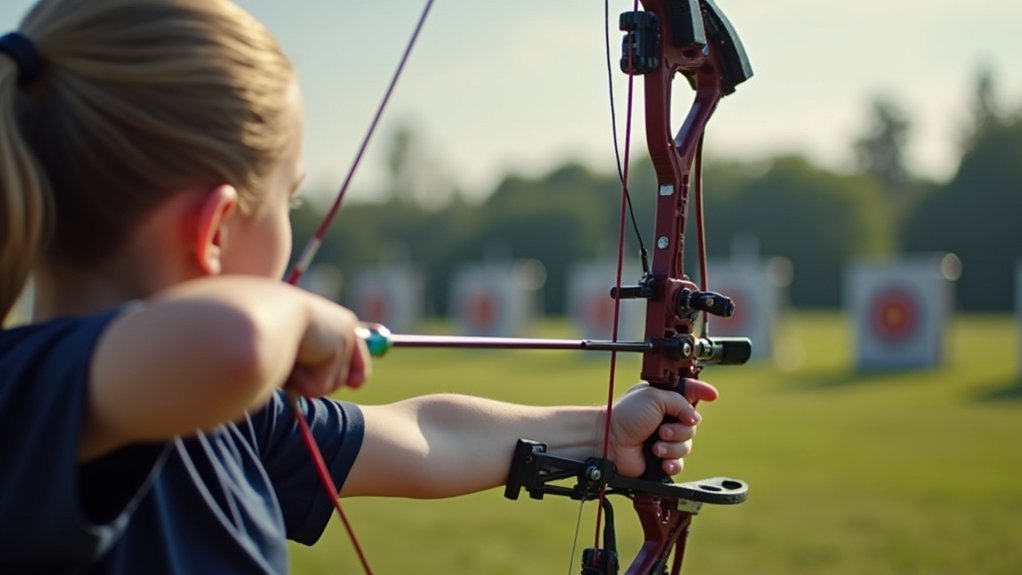
Achieving stable and consistent shots as a quadriplegic archer depends greatly on proper wheelchair mounting solutions. Your chair becomes an integral part of your shooting platform, requiring specific adaptations for ideal performance.
Look for systems that allow your bow to attach directly to your wheelchair frame, ensuring removable armrests to prevent interference with your shooting motion. Functional brakes are essential to maintain position during your shot sequence.
Metal framework mounts can effectively resist the bow’s force while protecting your wheels from limb contact during follow-through.
Consider bow holders that support the weight while maintaining proper spinal alignment. These solutions maximize your independence during shooting, though you might need assistance with nocking and drawing.
Custom adjustments to height and angle will accommodate your specific mobility needs and shooting style.
Specialized Aiming Devices and Laser Guidance
When traditional sighting methods pose challenges for quadriplegic archers, specialized aiming devices and laser guidance systems offer remarkable alternatives.
These technologies can transform your shooting experience through tactile, auditory, or visual assistance.
Laser guidance systems provide precise targeting by highlighting where your arrow will land, while tactile sighting devices let you aim through touch feedback.
For archers with limited mobility, assistive technology creates pathways to accuracy that weren’t previously possible.
- Mouth tabs allow string release without hand function
- Camera systems provide real-time feedback on your aim
- Tactile markers help identify positioning through touch
- Laser alignment tools integrate with specialized sights for improved accuracy
Your classifier assessment will determine which adaptive equipment is competition-authorized, though unauthorized aids can still benefit your training regimen.
Custom Adaptive Quivers for Easy Arrow Access
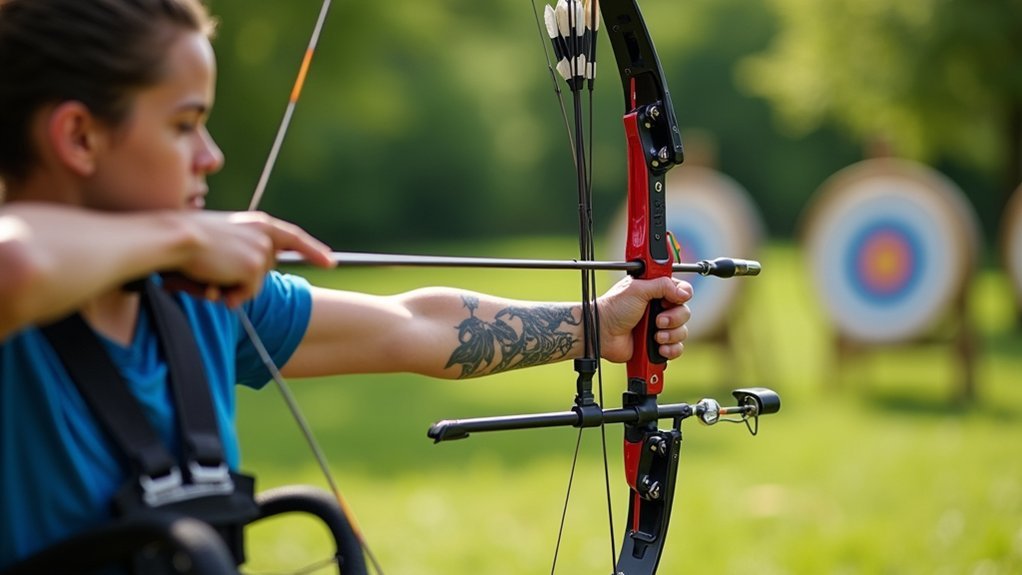
Custom adaptive quivers transform the archery experience for quadriplegic athletes by eliminating the constant struggle of arrow retrieval.
These specialized quivers attach directly to your wheelchair using clips or frames, ensuring arrows remain secure even during movement.
You’ll find various designs featuring open compartments or magnetized caps for quick access, with materials ranging from lightweight plastics to durable fabrics.
Many incorporate quick-release mechanisms and adjustable height settings for ideal alignment with your shooting position.
Safety remains paramount with these quivers, as they include protective padding and secure attachment systems to prevent accidental drops.
Modern innovations incorporate carbon fiber and aluminum construction for lightweight durability, while some feature electronic locking mechanisms for added security.
For maximum effectiveness, choose a quiver customized to your specific physical needs and arrow preferences.
Training Approaches for Quadriplegic Archers
While customized quivers address arrow access needs, effective training methods represent the foundation of successful archery for quadriplegic athletes. Your coach should assess your individual capabilities to develop a personalized approach focusing on equipment stability and your core strength development.
Wheelchair positioning is critical for consistency, with bow mounts either attached to your chair or on freestanding stands.
You’ll need specialized training in:
- Core strength exercises to improve torso stability while shooting
- Proper use of mouth tabs and release aids for independent shooting
- Balance techniques to compensate for mobility limitations
- Let-down procedures to safely release tension without injury
Training should foster independence while providing necessary support.
With adaptive feedback and positive reinforcement, you’ll develop confidence in your shooting abilities while coaches observe from positions that allow effective form assessment without interference.
Competition Opportunities and Classification Systems
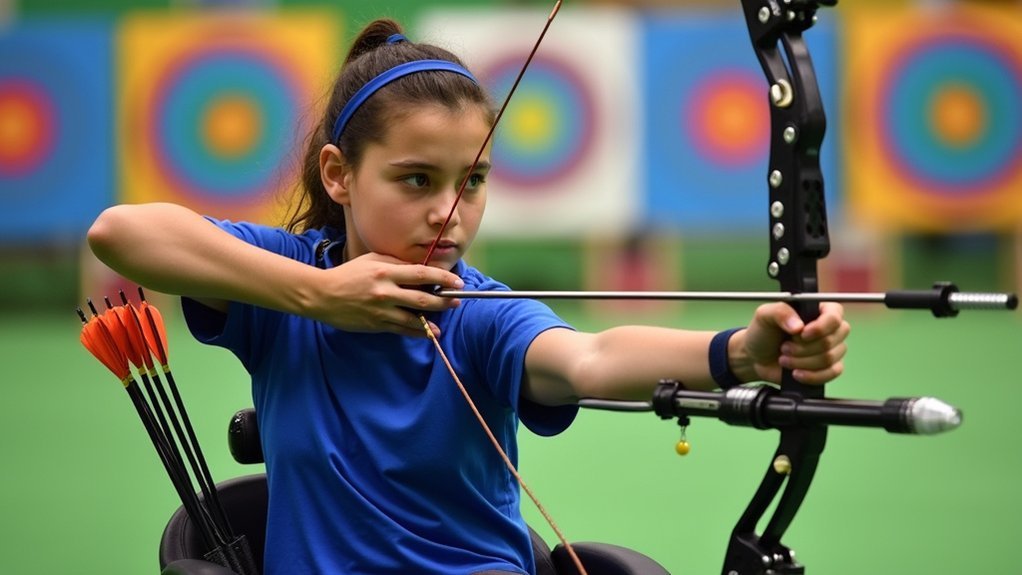
As you develop your archery skills, numerous competition pathways await quadriplegic archers at local, national, and international levels.
DASA’s Gateway Games and regional competitions in St. Louis, Columbia, and Texas provide excellent starting points. You can advance to Junior Nationals, Hartford Nationals, and ultimately Paralympic Games or World Archery Para Championships.
To compete officially, you’ll need a USA Archery membership and proper classification.
The classification process involves medical assessment and physical examination to determine your eligibility and category. World Archery classifies athletes as Standing (ST), Wheelchair 1 or 2 (W1 or W2), or Not Eligible (NE).
For quadriplegic archers, you’ll typically compete in the W1 class. Remember to carry your classification card and verify your adaptive equipment complies with World Archery standards.
Frequently Asked Questions
How Much Does Adaptive Archery Equipment Typically Cost?
Adaptive archery equipment costs vary widely. You’ll spend $900-$2,842 for mobility mounts, $117-550 for control devices and sights, and $250-700 for stands and draw kits. Basic setups start around $1,000.
Can Insurance Cover Specialized Adaptive Archery Equipment?
Yes, insurance can cover your specialized adaptive archery equipment. Look for policies with equipment insurance that specifically covers loss, theft, or damage to custom-made adaptive gear. Many providers offer tailored coverage for these needs.
What Maintenance Is Required for Sip-And-Puff Archery Systems?
You’ll need to replace filters regularly, create saliva traps in tubing, clean mouthpieces and tubes with soap and water, and maintain proper humidity control. Don’t attempt complex repairs yourself—seek manufacturer-approved service.
How Do Weather Conditions Affect Electronic Archery Release Aids?
Weather conditions greatly impact your electronic release aids. You’ll face challenges with humidity affecting circuitry, extreme temperatures changing battery life, and rain requiring waterproof protection. Wind won’t directly affect the device but influences your shot.
Are There Rental Options for Trying Adaptive Equipment Before Purchasing?
Yes, you’ll find rental options at archery ranges, Disabled Sports USA chapters, and local clubs. Try different adaptive setups before buying, as most places include equipment rentals in lesson fees for beginners.
In Summary
You’ve got options for pursuing archery despite quadriplegia. Whether you’re using sip-and-puff systems, mouth tab mechanisms, or electronic controls, adaptive equipment can make your archery dreams possible. With proper mounting solutions, specialized aiming devices, and custom quivers, you’ll overcome physical barriers. Don’t forget to explore training programs designed for your needs and competition opportunities where you can showcase your skills. Archery’s freedom awaits!

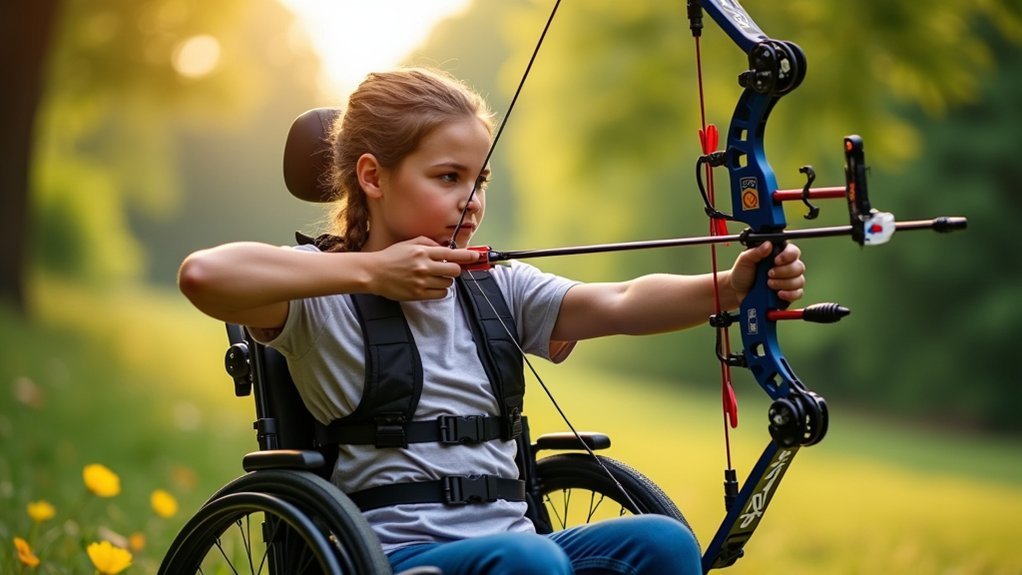



Leave a Reply